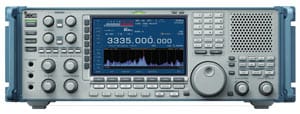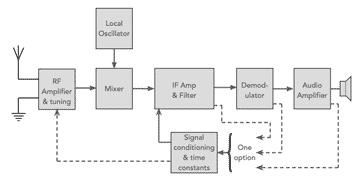Receiver Overload Performance: strong signal handling
Radio receiver strong signal handling & overload performance are often just as important as sensitivity and some other parameters - meeting all requirements requires careful RF circuit design.
Radio Receiver Overload / Strong Signal Handling Includes:
Strong signal performance basics
Blocking & desensitisation
Intermodulation distortion
Cross modulation
Receiver intercept point
One challenging area of the RF design of radio receivers is that if achieving a good strong signal and overload performance whilst also maintaining a high level of sensitivity.
The overload performance is important because the radio needs to be sufficiently sensitive to receive very weak signals, but it must also be able to manage the strong signals without overloading. This is a key requirement for many radio communications, wireless, mobile communications and other similar applications.
As the range of signals that any receiver needs to handle may extend over 100dB or more, the strong signal performance is important. Overloading can lead to effects that can mask the wanted signal and actually reduce the sensitivity.
There are several key aspects and parameters that detail the radio performance in the presence of strong signals, each of which is key to the performance in a particular area.
With the proliferation of cell phones, Bluetooth devices, Wi-Fi, NFC, as well as more traditional radio communications systems, it is necessary for all of these to work in the presence of the others which may be in close proximity and radiating signals on adjacent channels or nearby frequencies. Accordingly the receiver overload and strong signal handling capability is very important.

Image courtesy Icom UK
Key overload and strong signal performance parameters
The overall radio overload and strong signal handling performance is governed by a number of separate specifications and parameters.
These different parameters quantify the performance of the radio in different ways, looking at how it handles strong signals. These different parameters are important as they can describe how the radio will perform in real radio communications applications.
Each different parameter details a slight different aspect of the performance.
Receiver blocking: Radio receiver blocking occurs when a strong signal close to that being received reduces the sensitivity of the receiver. It is very important, especially in these days where there are many short range, and other longer range wireless cellular and other radio communications devices around.
It is quite likely that other devices will be transmitting a signal physically close by, and often on a channel that is relatively close. If the receiver is desensitised, then this can degrade the performance of the particular radio communications system in use.
Read more about . . . . Blocking & Desensitisation Performance
Intermodulation performance : Intermodulation distortion and intermodulation performance are important parameters for a receiver performance. The presence of intermodulation products gives rise to unwanted signals being generated which may mask the wanted signal. These intermodulation present themselves as signal and may appear as ‘real’ signals, sometimes making a channel or band that may have little activity, and much busier and full of signals. Selecting the right electronic components during the RF design phase of the project is essential for good performance.
Read more about . . . . Intermodulation Distortion Performance
Intercept point: The Intercept Point, or possibly more correctly, the third order intercept point gives an indication of the strong signal handling capacity of an amplifier, mixer or overall radio receiver. It is the level on a graph where the level of the third order products equal the wanted products, i.e. where the lines for the levels intercept.
Although the third order intercept point is an imaginary figure and cannot be measured directly, it provides an excellent figure of merit for strong signal handling.
Read more about . . . . Third Order Intercept Point.
Cross modulation : As the name implies, cross modulation manifests itself by transferring the modulation on one very strong signal onto other signals being received.
Cross modulation is not a specification that has major importance these days as it is mainly noticed where strong amplitude modulated signals are present.
Read more about . . . . Cross Modulation.
RF amplifier & receiver overload
One of the key elements of any receiver that governs its overload or strong signal handling capability is the RF amplifier. Its performance is key to the performance of the whole receiver.

Under normal conditions the RF amplifier of a radio receiver should remain linear with the output remaining proportional to the input. However, even the best RF amplifiers have limits to their output capability.
Beyond a certain point the output can no longer rise in proportion to the input as the amplifier enters a region where compression starts. When this happens the output starts to limit and it is less than expected of a perfect amplifier.
Compression in itself is not a problem for receiver overload performance. The absolute values of a signal are of little value and in any case the automatic gain control, AGC, used in many radio receivers means that the gain is reduced when strong signals are being received.
It is the side effects of compression give rise to major problems. Effects like intermodulation distortion, cross modulation, blocking and others mean that the operation of the radio receiver can be seriously impaired. It is these aspects which are of great importance for the overload performance of in the radio receiver design.
In view of the importance of the various aspects of overloading, a number of specifications quantify the various problems caused. However to look at these it is necessary to look at the basic effects and how they arise, and how the RF design and electronic components selected can affect the performance.
RF mixer & receiver overload
One electronic component within the radio receiver has a major bearing on the strong signal handling performance is the first mixer. The performance of this electronic component is probably more critical than many others. Selecting the right mixer technology and the right electronic component or components is very important.
Note on RF Mixing / Multiplication:
RF mixing or multiplication is a key RF technique. Using a local oscillator, it enables signals to be translated in frequency, thereby enabling signals to be converted up and down in frequency.
Read more about RF mixing / multiplication
To obtain the best radio overload performance a high level RF mixer should be used in the RF design. A high level mixer has a high level local oscillator input level. This enables it to cope with the high level signals that may give rise to problems with overload.
AGC automatic gain control
Many receivers have a scheme known as an automatic gain control built into their RF design. This circuit takes a sample of the signal, typically at the output of the IF stage if it is a superheterodyne radio, and then filters this to give a control voltage which is applied to earlier stages of the radio, thereby limiting the signal range that stages like the IF need to accommodate.

The AGC circuit designs work well for most situations, but it may not be able to prevent the radio receiver from overloading under all situations. This is particularly true when signals are off the received channel, because these signals will not affect the AGC, but will still be presented to first stages of the receiver before they are filtered out.
The RF circuit design also has to take account of the different types of modulation that may be encountered as these may require different time constants in the AGC circuitry. This is normally achieved by having slightly different filter networks using different electronic components within the AGC circuitry.
Input RF attenuator:
Some specialist radio receivers may incorporate an RF attenuator within the RF design. This can be used to reduce the RF input level at the input when strong signals are present. The attenuator is typically a switched attenuator having possibly an "in" and "out" position and may provide 20dB attenuation or thereabouts dependent upon the requirements.
Any radio receiver design will need to balance the requirements for strong signal handling and radio overload performance with those for other aspects of the design like sensitivity and other parameters. Achieving excellent strong signal handling and overload performance will be a balance of many factors including cost.
More Essential Radio Topics:
Radio Signals
Modulation types & techniques
Amplitude modulation
Frequency modulation
OFDM
RF mixing
Phase locked loops
Frequency synthesizers
Passive intermodulation
RF attenuators
RF filters
RF circulator
Radio receiver types
Superhet radio
Receiver selectivity
Receiver sensitivity
Receiver strong signal handling
Receiver dynamic range
Return to Radio topics menu . . .



